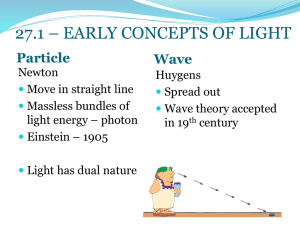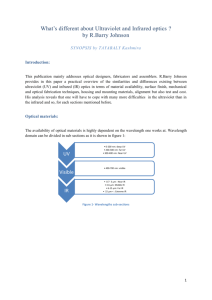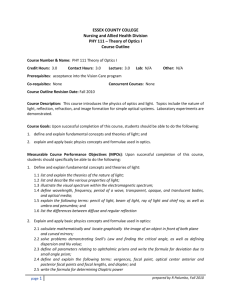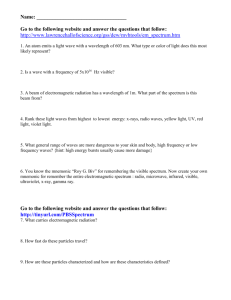Synopsis - The University of Arizona College of Optical Sciences
advertisement
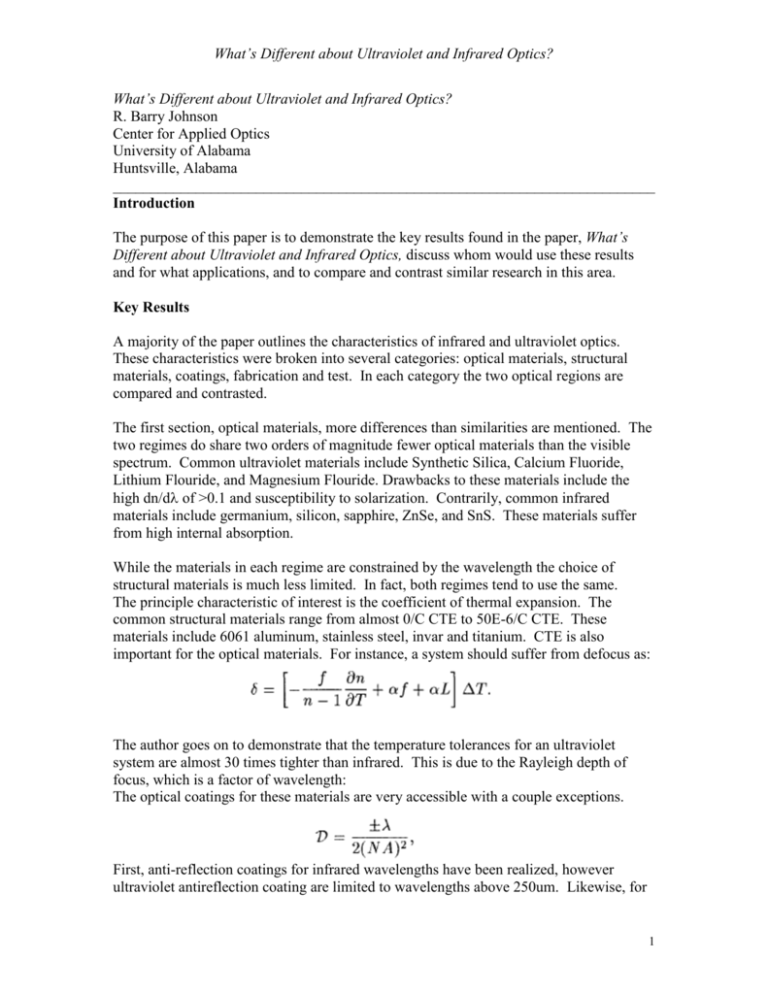
What’s Different about Ultraviolet and Infrared Optics? What’s Different about Ultraviolet and Infrared Optics? R. Barry Johnson Center for Applied Optics University of Alabama Huntsville, Alabama ________________________________________________________________________ Introduction The purpose of this paper is to demonstrate the key results found in the paper, What’s Different about Ultraviolet and Infrared Optics, discuss whom would use these results and for what applications, and to compare and contrast similar research in this area. Key Results A majority of the paper outlines the characteristics of infrared and ultraviolet optics. These characteristics were broken into several categories: optical materials, structural materials, coatings, fabrication and test. In each category the two optical regions are compared and contrasted. The first section, optical materials, more differences than similarities are mentioned. The two regimes do share two orders of magnitude fewer optical materials than the visible spectrum. Common ultraviolet materials include Synthetic Silica, Calcium Fluoride, Lithium Flouride, and Magnesium Flouride. Drawbacks to these materials include the high dn/d of >0.1 and susceptibility to solarization. Contrarily, common infrared materials include germanium, silicon, sapphire, ZnSe, and SnS. These materials suffer from high internal absorption. While the materials in each regime are constrained by the wavelength the choice of structural materials is much less limited. In fact, both regimes tend to use the same. The principle characteristic of interest is the coefficient of thermal expansion. The common structural materials range from almost 0/C CTE to 50E-6/C CTE. These materials include 6061 aluminum, stainless steel, invar and titanium. CTE is also important for the optical materials. For instance, a system should suffer from defocus as: The author goes on to demonstrate that the temperature tolerances for an ultraviolet system are almost 30 times tighter than infrared. This is due to the Rayleigh depth of focus, which is a factor of wavelength: The optical coatings for these materials are very accessible with a couple exceptions. First, anti-reflection coatings for infrared wavelengths have been realized, however ultraviolet antireflection coating are limited to wavelengths above 250um. Likewise, for 1 What’s Different about Ultraviolet and Infrared Optics? reflection coatings, ultraviolet is limited to above 150um. Whereas, infrared is not limited. Finally, the fabrication and test techniques for these two regimes share common methods (e.g. grinding and polishing), but require very different tolerances and test specifications. For example, infrared optics can simply be diamond turned, while the ultraviolet optics must be turned and processed several times to achieve a sufficiently small surface roughness. Polishing requirements are just as stringent for ultraviolet optics. The physical displacement surface requirement is 91nm for a 365um wavelength, compared to 2500nms for 10um wavelength. Thus, interferometer surface measurements for ultraviolet optics are much more difficult and time intensive than the infrared optics. Additionally, there are only a few places that exist in the US that make scattered flux measurements to this degree. Who would use this and for what type of application? Designers, fabricators and assemblers of infrared and ultraviolet optical system would use the results found in this paper. Systems such as a catadioptric optical system for an infrared scanner, ultraviolet catadioptric microscope objective, athermalized zoom lens and sub-micron lithography. The lens configurations shown with the catadioptric infrared scanner (Figure 1) and ultraviolet catadioprtric microscope objective (Figure 2) demonstrate the unique properties of different optics. For example, infrared optics have a much wider field-ofview than the ultraviolet optics. Ultraviolet optics has a much tighter tolerance on field flatness and distortion. Figure 1 (left) and Figure 2 (right): Catadioptric systems with infrared and ultraviolet optics respectively. 2 What’s Different about Ultraviolet and Infrared Optics? The Athermalized zoom lens (Figure 3) is accomplished by combining lens that are athermalized about central elements used for a zoom function. The passive athermalization method used for this system can only be applied to the infrared optics. Because there is a lack of optical materials in the ultraviolet which exhibit these characteristics no athermalization method has been established. Figure 3: Athermalized zoom lens with infrared optics. Submicron lithography systems (Figure 4) for the infrared are fabricated with tolerances as small as 0.5um. The manufacturing of such tolerances happens on a diamond turn and alignment is accomplished with an air-bearing table. Figure 4: Submicron lithography system layout with infrared optics. 3 What’s Different about Ultraviolet and Infrared Optics? Similar topics Similar topics are covered in literature specific to some of the applications mentioned in the previous section. These papers detail the development of a particular system with the respective characteristics in mind. In the book, Thermal Imaging Systems, Michael Lloyd summarizes the function of these systems and what components are needed to realize one. Because thermal radiation extends beyond our eye’s detection a device was developed to image objects irradiating on the thermal scale. The systems are to account for different wavelengths where emissivity, temperature and reflectivity differ dramatically. On page 255 Lloyd discusses the common optical materials used for these systems. Materials were chosen for their mechanical strength, hardness, low thermal expansion and AR coating compatibility. Microscope Objectives covered in Applied Optics and Optical Engineering accomplishes what Lloyd had done for infrared thermal imaging systems; for ultraviolet systems. Here greater care was taken to choose materials, optical and structural and tolerance the parts for the systems. A method for machining infrared parts was illustrated in Analysis and Performance Limits of Diamond Turned Diffractive Lenses for the 3 and 8-12um Region. This paper gives a closer look at the fabrication and test requirement for infrared optics. Conclusion It has been illustrated in this paper that there are many characteristic differences in ultraviolet and infrared systems. Differences include optical, structural, coatings and fabrication and test requirements. Because of the very high requirements of ultraviolet lenses many methods have yet to be developed. Furthermore, the knowledge of these differences has helped create several applications for imaging, both thermal and submicron scale. Lastly, the paper discusses other publications, which cover this topic in greater detail and gives more insight in how to work with these seemingly similar materials. References R.B. Johnson, What’s different about ultraviolet and infrared optics?, SPIE, CR43, Optomechanical Design (July 1992) J.M. Lloyd, Thermal Imaging Systems, Plenum Press, New York, pp 257-267 (1975) J.R. Benford, “Microscope Objectives,” in Applied Optics and Optical Engineering, R. Kingslake Ed., Academic Press, New York, pp. 172-174 M.J. Riedl and J.T. McCann, “Analysis and Performance Limits of Diamond Turned Diffractive Lenses for the 3- and 8-12 Micrometer Regions,” Proc. SPIE, Vol CR38, pp. 153-163 (1991) 4

